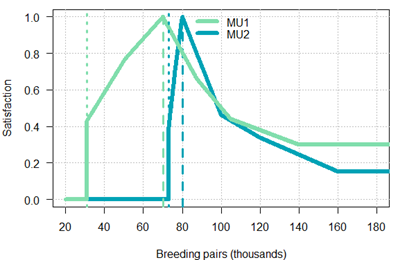The purpose of this project was to prepare a reliable decision-making tool to identify the optimal management strategy(ies) for the NW/SW European population of greylag geese.
The decision tool consists of a:
The population model is a matrix model divided into a breeding period and a non-breeding period. During the breeding period, the population is divided into two management units: the migratory unit, centered in Scandinavia (MU1), and the primarily sedentary unit, centered in the Netherlands and neighbouring countries (MU2) (Figure 1, left). In the non-breeding period, the population is divided into a northern area (North), consisting of individuals from both MU1 and MU2, and a southern area (South), consisting primarily of individuals from MU1 (Figure 1, right). At present, the model is parameterised with primarily historical values for, e.g., population size for MU1 and MU2, survival and reproduction. When new parameter estimates become available, the model and management strategies can be updated.
In collaboration with the international work group, a value model was developed that describes how the satisfaction of member states varies when the number of geese in each management unit deviates from the population targets (Figure 2). The value model shows that the member states of MU1 are generally satisfied with a wider range of population sizes than the member states of MU2. Furthermore, for both management units, member states are more satisfied with large population sizes than small population sizes. Dissatisfaction with small population sizes decreases fastest for MU2.

Figure 2. Value models for the two management units (MU1 and MU2) of the NW/SW European population of greylag geese. The dashed vertical lines represent the targets of the two management units, and the dotted vertical lines represent the favourable reference population (FRP) of the management units.
The evaluation of the management strategies and the related population sizes for the two management units shows that there is not one optimal management strategy, but many (50) management strategies had a satisfaction of more than 0.85. In general, however, it can be said that the strategies that best met the population targets of the management units (70,000 and 80,000 breeding pairs for MU1 and MU2, respectively) are either those that have relatively high levels of regulation during the breeding season (April to July) or relatively high levels of hunting during the wintering/non-breeding period (August to March).
An important learning from the project is thus also that, in addition to meeting the population goals, when a management strategy has to be chosen, it is also important to consider feasibility, costs and legal restrictions (e.g. the Bird Protection Directive).
At the June 2023 annual working group meeting of the European Goose Management Platform, the member states chose to focus on management strategies that have relatively high levels of hunting during the wintering/non-breeding period (August to March). However, it will still be up to the individual member states to determine the national hunting and regulatory levels, depending, among other things, on field damage levels.
Read more about the European Goose Management Platform and the decisions from the annual work group meetings here: https://egmp.aewa.info/.
The NW/SW European population of Greylag Geese has increased more than seven-fold since the 1980s, resulting in substantial increases in conflicts with agricultural and in the risk of aircraft strikes. The International Single Species Management Plan for the Greylag Goose (Anser anser) (ISSMP) (Powolny et al. 2018) mandated the development of an Adaptive Flyway Management Programme (AFMP) to help address the growing socio-economic concerns associated with this population and to provide for sustainable hunting opportunities. This project will address a key element of the AFMP, which is to “establish an internationally coordinated population management programme for both management units, including offtake under hunting and, if necessary, under derogations, encompassing monitoring, assessment and decision-making protocols.”
In the absence of population models to guide decisions about offtake, the European Goose Management International Working Group agreed in 2020 to reduce population size by 15% over 10 years by increasing the level of offtake. However, the info-gap analysis used to support this decision (Johnson and Koffijberg 2021) does not take into account special needs and population trajectories of the two management units, and thus it carries a high risk of not meeting the population targets if not replaced by a more reliable decision-making tool. The use of the info-gap analysis is scheduled to be discontinued in 2023.
This project involves development of a flyway-wide decision model for use in investigating population-management strategies for Greylag Geese. This decision model will consist of three primary elements: (a) a flyway model of population dynamics; (b) a set of decision alternatives (i.e., varying levels of offtake in each management unit); and (c) a value model: